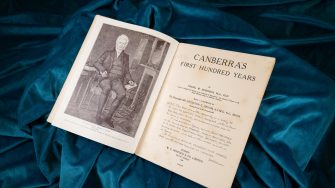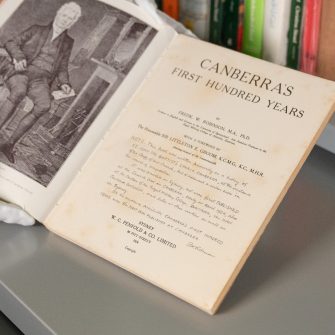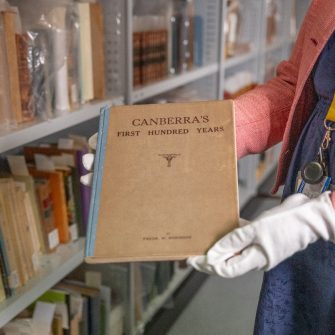
UNSW Canberra Special Collections is home to a special edition of Frederick Walter Robinson’s , which is believed to be the first book published in Canberra in early April 1924, marking 100 years since the book was published.
Robinson’s work was ‘originally intended to be a sketch of St John the Baptist’s Church, but grew in the course of writing into a history of Canberra and its neighbourhood’. It was the first work to discuss theories on how the name ‘Canberra’ came to be, including its Indigenous origin.
Susan Thomas, Assistant Curator at the UNSW Canberra Special Collections, said the book itself is not exceptionally rare, as around 10 other libraries in Australia hold the first edition but there is something within its pages that makes this copy unique.
“What makes the UNSW Canberra edition special is that it is Frederick Robinson’s own copy, and he annotated the title page with some interesting information about its publication history,” she said.
“I love Robinson’s devotion to his book and its subject which resonates in the text, and his annotations. Not content to limit his history to that of St John’s, he becomes fascinated with the site and region on which it stands and interweaves its history with that of ‘place’ including that of the traditional inhabitants.
“In 1924 he is already lamenting the demolition of early buildings to make way for the new Canberra, and advocates for the use of local Aboriginal names for places (suburbs, roads etc) rather than imposed names such as ‘National Circuit’.
‚ÄúThat he took pains to inscribe the specific publication history of the book on its title page, and dedicate the copy to the Royal Military College Library on 2 February 1963, exactly 50 years to the day after he joined the staff there in February 1913, speaks of his personal connection to the book, as do the minor corrections and additions that he could not help but add in pen half a century later to add to the ‚Äòcompleteness‚Äô of the book.‚Äù¬Ý
Robinson notes on the title page that while the book was printed in Sydney, it was ‘published’ in Canberra, in the sense that printing of the publication was initiated and paid for by the Canberra publisher, the Clergy of St John’s in Reid.
He also notes the book was first distributed publicly via the Church Door, the Royal Military College (RMC) canteen and the Hotel Canberra bookstall in April 1924.
“As a curator and book historian, I really love the way in which the book and its detailed inscription evoke a picture of early 1920s Canberra and its little bookstalls, not captured elsewhere in other sources I have read,” Ms Thomas said.
“As there was no dedicated bookshop until the Canberra Book Club was established in Manuka in 1927, books were distributed for sale to the reading public at community hubs, small outposts of settlement, interspersed by paddocks and dirt roads.”
As well as being a much-admired teacher and man of letters (affectionately known as Doc Robbie), Robinson had a special interest in the history of Canberra, kindled when he first moved to the region and was appointed Associate Professor in Modern Languages at the newly established Royal Military College, Duntroon in 1913.
Robinson was then appointed Lecturer in English and German at the University of Queensland in 1923, where he founded the Fryer Library of Australian Literature. The Fryer Library reading room is named after Robinson.


